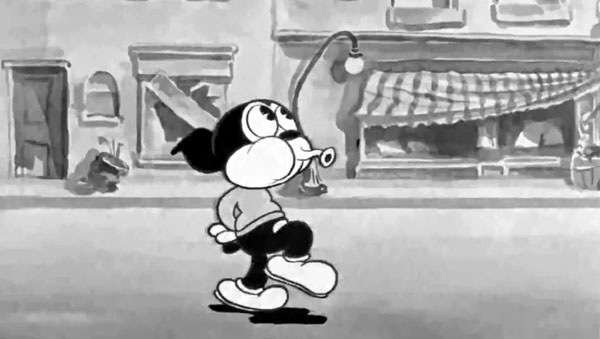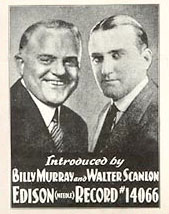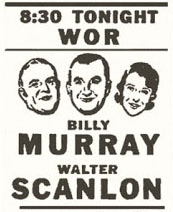
When Max Fleischer was involved in producing the early “Screen Songs” and “Talkartoons” for release by Paramount, his musical people, including his brother Lou and bandleader Manny Baer, would hire various singers to sing in solo and ensemble. Considering how many singers were working the greater New York area, he’d have had a great choice of vocalists.
 Yet there were two singers who show up repeatedly in the “Screen Songs” cartoons. They never got any screen credit. But any record collector who knows records of the 1920’s and 1930’s would recognize them immediately.
Yet there were two singers who show up repeatedly in the “Screen Songs” cartoons. They never got any screen credit. But any record collector who knows records of the 1920’s and 1930’s would recognize them immediately.
Their professional names were Billy Murray and Walter Scanlon.
When Fleischer started to make these shorts, Murray was fifty-two years of age. And he was a veteran of minstrel shows, stage performances–and, especially, of phonograph records.
Billy Murray was, without doubt, the pre-eminent singer of comic songs on early records. His career on disks and cylinders went back to 1903, and he’d tried his tonsils on nearly every kind of comic song known in Tim Pan Alley.
Walter Scanlan–born Walter Van Brunt–had almost as long a career as Murray. He went back on record to around 1909, and could do a mean impression of Billy Murray in his salad days. But he could also sing more serious material–not grand opera, by any stretch of the imagination, but the more romantic popular songs.
 He took up the name “Scanlan” (sometimes spelled ‘Scanlon’) in the late 1910’s, after becoming associated with songs in the Irish style.
He took up the name “Scanlan” (sometimes spelled ‘Scanlon’) in the late 1910’s, after becoming associated with songs in the Irish style.
Murray and Scanlan had worked together off and on for some years. But they started up a formal duet partnership in 1928, and began recording for Edison, Victor, and some of the low-priced labels.
They worked, separately and together, for Max Fleischer during 1929 and 1930. Their voices appear in a short made for Western Electric, explaining the ins and outs of sound-on-film recording. And they show up–again, both separately and together–in about fourteen “Screen Songs” cartoons from 1929 and 1930. (That’s at least fourteen that we know of. The Wikipedia page for “Screen Songs” indicates that a lot more were made than have shown up on YouTube.)
Sometimes, Murray would just deliver the “alter call” that preceded the actual appearance of the song on screen, with lyrics and Bouncing Ball. On Oh, You Beautiful Doll, he has “altar call”, while Walter leads the singing. (That’s a song he would surely have remembered, as he had recorded it with the American Quartet back in 1911.)
Sometimes they both get involved in the “altar call”, while letting someone else do the vocal heavy lifting. On The Prisoner’s Song (a relatively recent song to be used this early), they deliver, in various dialects, a poem about “dear Sing Sing”, which leads into the song proper, a National Earache in its day.
And, sometimes, Billy would sing–and,in his way, bring back memories (surely for himself,at least) or earlier days. Billy had recorded “I’m Afraid To Come Home In The Dark” for several companies back in 1908. He gets to do it again for the Fleischer cartoon, using, in one chorus, his mock-drunk voice which seems to fit the song.
Here are some cartoons that have Billy urging his audience to join in the singing:
“Oh, You Beautiful Doll”
“In The Shade Of The Old Apple Tree”
“The Prisoner’s Song”
“Come, Take A Trip In My Airship”
“In The Good Old Summertime”
“I’d Climb The Highest Mountain”
“Any Little Girl Who’s A Nice Little Girl’
“Mariuch'”
And here are some on which Billy sings, sometimes in a quartet, which may include Walter Scanlan:
“I’ve Got Rings On My Fingers”
“Bedelia”
“I’m Afraid To Come Home In The Dark”
“In My Merry Oldsmobile”
There may well be others of the “Screen Songs” of the period in which the voices of Billy Murray and Water Scanlan can be discerned.


 James Parten has overcome a congenital visual disability to be acknowledged as an expert on the early history of recorded sound. He has a Broadcasting Certificate (Radio Option) from Los Angeles Valley College, class of 1999. He has also been a fan of animated cartoons since childhood.
James Parten has overcome a congenital visual disability to be acknowledged as an expert on the early history of recorded sound. He has a Broadcasting Certificate (Radio Option) from Los Angeles Valley College, class of 1999. He has also been a fan of animated cartoons since childhood.












































Bill Murray actually made his first cylinders in 1897, for Peter Bacigalupi’s shop on Market street in San Fransisco.
This is More evidence that Viacom has unnreleased classics and needs to release them. Maybe we can get Warner Archive to buy all the orginal negitives from them. Warner clearly cares more about their classics than Viacom. Warner released a DVD set with the Ten Commandments and Ben Hur. Maybe They should buy the cartoon negatives and the rights from Paramount. Keep all the titles. And give them a good proper restoration.
Thank you for this wealth of information. I enjoy the screensongs; in some cases, they remind me of Spike Jones before his takes on popular songs became as large as the songs he parodied. It is wonderful to discover more Fleischer cartoons.
Billy Murray and Walter Scanlan were essentially the first Fleischer Studios voice artists starting with FINDING HIS VOICE and continued to be used periodically during the first two years of sound Fleischer cartoons. This and other such details can be found in my forthcoming book, THE ART AND INVENTIONS OF MAX FLEISCHER: American Animation Pioneer.
Interesting how there are borders around the main action scenes in both cartoons. I’m speculating here, but in these early sound titles, when there were competing sound-on-film and sound-on-disc systems, they may have done this as a hedge, since those prints with on-film tracks had to commandeer some picture area on the left side of the screen.
By adding a border, you made sure nothing important would be lost (notice how everything seems to be framed to the right?) when projected, whereas in a house running a sound-on-disc print (if such were ever actually made) you’d get the whole left-to-right picture, properly centered. Make sense?
A most enjoyable article thank you.
Watching these 1929 cartoons reminds me of how far animation techniques came just a couple of years later. They are truly in black and white, not the grey scale that we now call “black and white.” And you can tell that the animators had yet to perfect the art of synchronizing dialog – notice how slowly the characters speak. Nonetheless, these cartoons are distinctively Fleischer.